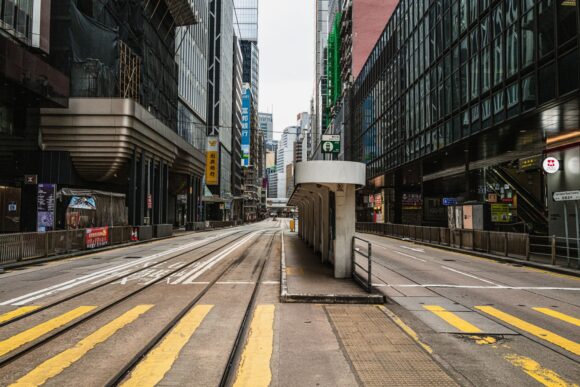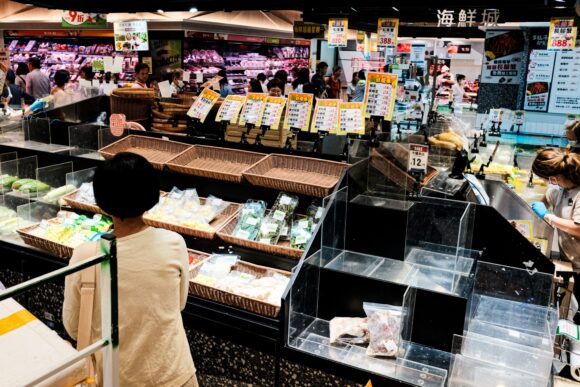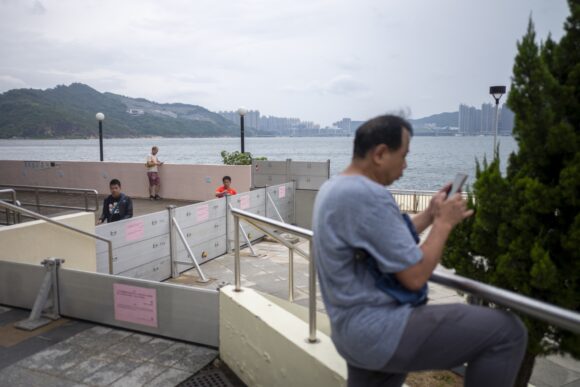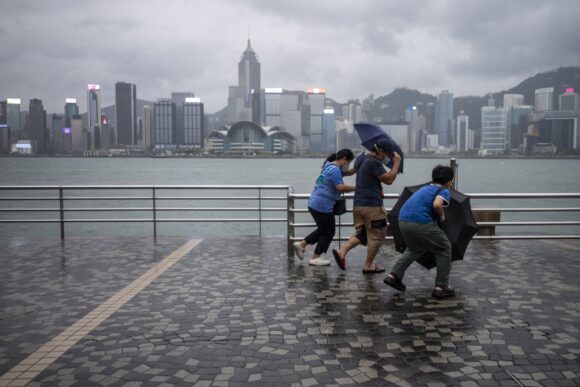Hong Kong was starting to feel the impact of Super Typhoon Saola as winds reached hurricane force and rain lashed the city.
The government said it will raise the No. 9 storm signal — the second highest — at 6:20 p.m. That will be the first time in three years such a warning has been issued. The city earlier closed the stock market along with schools and grounded most public transportation ahead of the storm’s arrival later Friday.
The storm, which was 90 km (56 miles) away from the financial hub at 6 p.m., currently has sustained winds of 210 km/hour near the center, according to the local observatory. That makes it as strong as a category 4 major hurricane on the Saffir-Simpson wind scale.
Gale force winds were affecting the territory, with occasional storm force winds offshore and hurricane force winds on some high ground, the observatory said in its latest update. There were also heavy squally showers, it said.
The storm, which is on track to be the strongest to affect the city since at least Mangkhut in 2018, is a major test for Chief Executive John Lee’s government. Mangkhut provoked public criticism after roads remained blocked for days by some of the tens of thousands of trees toppled by the typhoon and people struggled to get to work.
Saola is forecast to be within 50 km south of Hong Kong late Friday and early Saturday, the observatory said, warning that a storm surge will cause water levels to rise rapidly in low-lying coastal areas. The maximum water level may be similar to when Mangkhut hit Hong Kong, it said. Mangkhut was 100 km away from the city at its closest point.
Chief Secretary Chan Kwok-ki, who is leading a government task force to deal with the storm, warned residents to stay indoors.
“This can be a very destructive typhoon,” the chief secretary said Thursday, flanked by heads of various government departments. “We hope to minimize the damage.”

In the past 40 years, only five storms have prompted the raising of the highest signal in Hong Kong, according to observatory data. The No. 10 signal means hurricane force winds reaching a sustained speed of at least 118 km an hour.
Residents took advantage of the calm conditions on Friday morning to do some outdoor exercise, walk their dogs and stock up on food before the storm arrived. At one Wellcome supermarket in Wanchai on Hong Kong island, vegetables, fresh meat and hot food were running out by mid-morning, while instant noodles and pasta were in short supply.
About 460 flights in total have been canceled on Friday, according to the local airport authority. Cathay Pacific Airways Ltd., the city’s flag carrier, said it halted all Hong Kong flights from 2 p.m. Friday until 10 a.m. Saturday.
In Hong Kong, all inner harbor and outlying islands ferry services were suspended, along with all bus services.
Nearby Shenzhen airport halted all flights from noon, the airport operator said. Businesses closed from 4 p.m., while transport would stop three hours later, the government said. Trains traveling to and from Guangdong province would be halted from 8 p.m. Friday to Saturday evening.
The Hong Kong exchange halted stock trading because of rules requiring it when signal no. 8 or above is in place. Trading halts due to severe weather are seen as increasingly antiquated given that the global finance industry adjusted to remote working during the pandemic.
With most orders now received and executed electronically, the case is growing for Hong Kong to ensure continuous trading in bad weather. Financial Secretary Paul Chan said earlier this year that the city will explore arrangements to allow stock trading under severe weather.

China’s national weather authorities reiterated their highest alert for the typhoon on Friday morning. They warned of severe weather in the coastal provinces of Fujian and Guangdong, and urged local officials to be ready for flash flooding. China dealt with several bouts of extreme weather this summer, with dozens of deaths in northern areas including Beijing that were caused by flooding from Typhoon Doksuri.
Another storm is expected to affect Taiwan and eastern China in coming days. Severe tropical storm Haikui, with maximum sustained winds of 110 km per hour, is forecast to be close to northern Taiwan on Saturday evening or Sunday morning before making landfall in mainland China near Fuzhou.
Currency and fixed income markets in the Philippines were closed on Friday after government offices including the central bank were shut due to monsoon rains enhanced by Saola and other storms.

–With assistance from Jing Li, Philip Glamann, Filipe Pacheco, Danny Lee, Luz Ding, Dominic Lau, Olivia Tam and Alfred Liu.
Photograph: Pedestrians brace from the wind and rain on the waterfront in Tsim Sha Tsui district during a No. 8 storm signal raised for Super Typhoon Saola in Hong Kong, China, on Friday, Sept. 1, 2023. Hong Kong hunkered down on Friday as officials and residents prepared for the impact of Super Typhoon Saola, which is forecast to hit the city toward the end of the day. Photo credit: Justin Chin/Bloomberg
Topics Catastrophe Natural Disasters
Was this article valuable?
Here are more articles you may enjoy.



 Pet Insurance, Agents Gets a Shorter Leash Under Bill DeSantis Signed Into Law
Pet Insurance, Agents Gets a Shorter Leash Under Bill DeSantis Signed Into Law  Marsh Sues Aon, Ex-Team Leader Over Exit of 20 Construction Surety Employees
Marsh Sues Aon, Ex-Team Leader Over Exit of 20 Construction Surety Employees  Group Sues California Department of Insurance Over FAIR Plan Surcharges
Group Sues California Department of Insurance Over FAIR Plan Surcharges  White House Seeks to Bring Financial Regulators Under Its Sway
White House Seeks to Bring Financial Regulators Under Its Sway 

